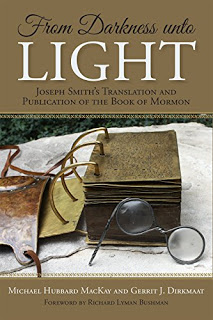In 1834-5, Joseph Smith and Oliver Cowdery wrote a series of essays on Church history and doctrine (the first “gospel topics essays”) to refute an 1834 anti-Mormon book titled Mormonism Unvailed.
Now revisionist LDS historians are using Mormonism Unvailed to refute Joseph Smith and Oliver Cowdery.
 Among other things, they are claiming that Joseph Smith didn’t really use the plates when he translated. Instead, according to these revisionists, the plates were left covered by a cloth throughout the translation process and Joseph merely read the words of a seer stone in the bottom of a hat.
Among other things, they are claiming that Joseph Smith didn’t really use the plates when he translated. Instead, according to these revisionists, the plates were left covered by a cloth throughout the translation process and Joseph merely read the words of a seer stone in the bottom of a hat.
In my view, this is a grave mistake.
Worse, the Church History Department is accepting their spin. The Correlation Department is implementing the revisionist history throughout the Church. Missionaries are being told to teach people what the revisionist historians are promoting. This is causing confusion and uncertainty.
I think this is a disaster for the same reasons Oliver and Joseph responded to the claims of Mormonism Unvailed in the first place, all the way back in 1834 and 1835.
I emphasize that these are merely my personal conclusions, based on my own research and careful reading of this book and the sources they cite and omit. None of this is personal, of course; we’re merely dealing with words on pages, not people. The authors are faithful LDS, careful scholars, and nice people. I just think this book seeks to confirm a bias about the plates and the translation process that also happens to support M2C (the Mesoamerican/two-Cumorahs theory).
_____
In October 1834, Oliver Cowdery published the first of a series of eight essays he wrote with the assistance of Joseph Smith. I call these the first “gospel topics essays” because they address important issues involving Church history and doctrine that remain relevant today. They were originally published as letters to W.W. Phelps in the Church’s newspaper in Kirtland, Ohio, titled the Latter Day Saints’ Messenger and Advocate.
For example, essay (letter) IV is available online here:
https://archive.org/stream/latterdaysaintsm01unse#page/76/mode/2up/search/Letter+IV
Soon after the eighth essay was published, President Frederick G. Williams, Second Counselor in the First Presidency, began copying them into Joseph’s personal history. You can see them in the Joseph Smith Papers today, such as essay IV here:
http://www.josephsmithpapers.org/paper-summary/history-1834-1836/64
Also in October 1834, the anti-Mormon book Mormonism Unvailed was published in nearby Painesville, Ohio. You can see it here:
https://archive.org/details/mormonismunvaile00howe
The influence of Mormonism Unvailed persisted for years. (Actually, with the book From Darkness Unto Light its influence has been rejuvenated.)
During Joseph’s lifetime, President Cowdery’s essays were republished in Church newspapers for everyone to read and re-read them. This includes the Times and Seasons, the Millennial Star, the Gospel Reflector, and The Prophet. The essays were cited by Church leaders in later years. Part of Letter I is canonized in the Pearl of Great Price. The essays were published again in Utah in the Improvement Era when Joseph F. Smith was the editor.
Yet these essays have never been published in the Ensign. They have been essentially forgotten and overlooked. Worse, they have been specifically repudiated by some revisionist historians and Book of Mormon scholars. M2C intellectuals at BYU/CES and the Correlation and History Departments even teach that President Cowdery was lying in Letter VII.
Today, it seems the revisionist historians rely more on Mormonism Unvailed than on President Cowdery’s letters.
_____
Source: Book of Mormon Wars
